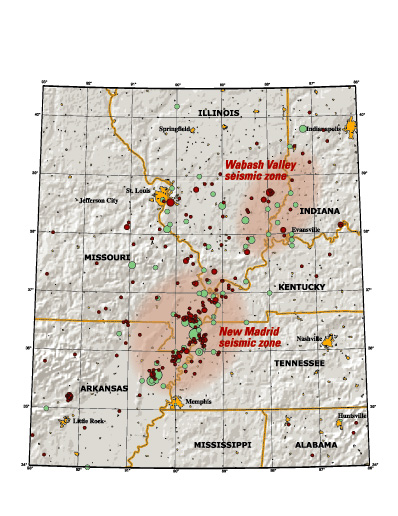The strong ground shaking and
resulting
catastrophic losses in the 1994 Northridge and the 1995 Kobe, Japan,
earthquakes reinforced the need for the USGS to concentrate its efforts
where the risks are highest, in the Nation’s urban areas. If
risks
are to be mitigated and plans made for recovery, officials need seismic
hazard maps for metropolitan areas at a scale of 1:24,000 . The National
Seismic Hazard Maps show the potential for damaging earthquakes
and the strength of ground shaking on a much broader scale, and do not
take into account local and regional geological structures and soil
conditions,
which may have strong amplifying or damping effects on ground
shaking.
Urban
seismic hazard mapping
activities were initiated by the USGS in 1998, with three projects
focussed on high-resolution seismic hazard assessments in at-risk urban
areas of the U.S. These assessments reflect local conditions and also
address ground failure hazards such as liquefaction and
earthquake-triggered
landslides. Projects were started in the eastern San Francisco Bay
region, Seattle,
and Memphis.
|

Map of the New Madrid
and
Wabash Valley seismic zones. Red circles indicate earthquakes that
occurred from 1974 to 2002 with magnitudes larger than 2.5 (University
of Memphis). Green circles denote earthquakes that occurred prior to
1974 (USGS Professional Paper 1527). Larger earthquakes are
represented by larger circles. From USGS Fact Sheet 131-02, " Earthquake Hazard in the Heart
of the
Homeland"
|
The Memphis
project is nearing completion and lessons learned are being applied to
new projects developing in the urban areas of St. Louis
(Missouri
and Illinois) and the Evansville (Indiana, Kentucky, and Illinois). In
each urban area, publicly available, digital geologic and geotechnical
databases are or will be developed and high-resolution seismic hazard
maps prepared. The primary focus is on production of
probabilistic hazard maps, but the same information also is being used
to produce scenario earthquake maps and long term forecasts of
earthquake probabilities (see glossary for definitions). All mapping projects
are done in close coordination with State geologists and local working
groups, such as the Central
U.S. Earthquake Consortium (CUSEC) emergency managers, CUSEC State Geologists, and the Mid-America Earthquake
Center.
|
The urban hazard mapping process and its products have
the potential to impact future National
Seismic Hazard Maps as data and models developed for the urban
mapping products will be used in national map updates. While not
meant for site-specific applications, the urban hazard maps will
provide guidance for those developing and enforcing building codes,
setting insurance rates, siting and designing public and private
facilities, and developing and implementing emergency response and
mitigation plans. They also serve as educational tools, helping to
raise the awareness of seismic hazard in the respective communities and
throughout the Central and Eastern U.S.. Finally, they focus
research so that it serves the public good while advancing our basic
scientific understanding, which in turn improves the accuracy of our
products.
|